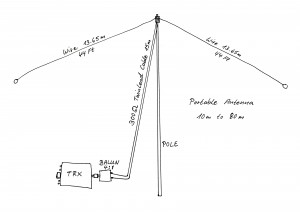Beam:
OptiBeam 11-3 for 10 – 15 – 20 5/3/3 Elements
Hy-Gain DB-1217 for 12 – 17 4/3 Elements

Wire:
Doublet 2 x 31m as inverted V 30 – 40 – 80 – 160
Vertical for 40 – 80 (homemade)


Doublet with 300Ω Twinlead Cable mounted on
a fiberglass pole by DX-Wire mainly used portable
on EA8/DL2MDU, CT9/DL2MDU, 8Q7CF,
D44TUK & D44TUQ


7 band vertical for the suitcase or travel bag
This article describes an antenna for portable operation on 7 HF bands. The outstanding features are high efficiency and very low measurements in size.
That give us the advantage to take it on holiday style DXpeditions. I used it as
CT8/DL2MDU from Sao Miguel on the Azores in 2023 and as 9H/DL2MDU from
Gozo Isl. with 5W QRP out of a (tr)uSDX in March 2024
In the following lines I will show the parts of the antenna as well as the steps
to build it by yourself. But first some theory to understand the working principle before starting with a bill of materials. The antenna is a quarter wave Vertical or Groundplane, made with a telescopic rod, two coils for the base loading inductance and four radials. See the circuit below.

The Idea is from Joe Everhart, (N2CX). His full article can be read on the July 2017 issue of The QRP Quarterly. QRPGuys had adapted his 40-30-20m portable vertical antenna design using switched toroids for the base loading inductance into a lightweight antenna for an easy outdoor setup.
My personal intention was to find a solution to use this genius working principle for 7 bands. Today are many materials available to make the radiator of the antenna adjustable.
There are some antennas on the market with telescopic rods and adjustable coils.
I decided to use a telescopic rod and two coils on toroids together with the two jumpers made from wires with alligator clips.
While the QRPGuys intended a lightweight low power version of the antenna, I was thinking of a version for 100 watts+ with acceptable weight and measurements for the drop off baggage. My choice of toroids is the T184-2 (red) for L1 and L2. The enameled copper wire is AWG 16 (1.3 mm) For the jumper cables I used silicone probe wires with alligator clips on one end.
For more details see the pictures.



